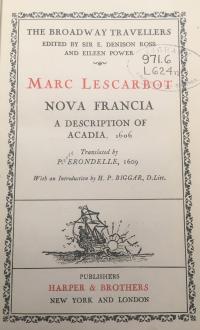Marc Lescarbot

Marc Lescarbot (lawyer, traveller, and writer) was born circa 1570 at Vervius in Thiérache, a frontier region between France and the Spanish Netherlands, and died in Prestes, France in 1642 (Baudry). He studied law in France, translated many works from Latin to French, and published poetry, such as Poèmes de la paix, Adieu à la France, and La défaite des sauvages armouchiquois (Baudry). Lescarbot sailed for Acadia in May 1606 at the invitation of one of his clients, colonizer Jean de Biencourt de Poutrincourt. He stayed there until 1607, when the colony was abandoned (Reid). Based at Port-Royal, Lescarbot travelled widely in Acadia and became interested in the problems and opportunities of New World colonization as well as the way of life of the region's Indigenous peoples. In 1609, he began publishing about his time in Acadia, bringing out the first edition of his most well-known work, Histoire de la Nouvelle-France. He followed up with successive editions of Histoire in 1611–12 and 1617–18.
Histoire de la Nouvelle-France covers the early voyages of Jacques Cartier, Samuel de Champlain, Jean-François Roberval, the Marquis de la Roche, Troilus de la Roche de Mesgouez, Messieurs de Monts and Poutrincourt (Lescarbot 9-17). It also provides insight into the lives, traditions, and practices of the Indigenous peoples who lived in Acadia and Quebec. Although the book is titled a history, it also expresses its author’s own opinions on the economic and political benefits of the colonies for France. All the editions of the Histoireinclude, as an appendix, a short collection of poems called Les muses de la Nouvelle-France. These poems by Lescarbot treat the Indigenous people and the region in language that invokes Roman and classical mythology. An example of this is found in the poem “Troisieme sauvage”:
Ce n'est seulement en France
Que commande Cupidon
Mais en la Nouvelle-France,
Comme entre vous, son brandon
S'allume; & de ses flammes
Il rotit noz pauvres ames,
Et fait planter le bourdon. (Lescarbot, Les muses)
Lescarbot was also an important playwright. His play, Le théâtre de neptune en la Nouvelle-France, is considered to be the first documented European-styled drama performed in Canada (Charlebois and Nothof). This play took place in Port-Royal on 14 November 1606. The play combined music, recital, and choral song to depict Neptune and other classical figures, as well as Indigenous people welcoming travellers returning from a long sea voyage (Charlebois and Nothof). The play was published in Lescarbot’s Les muses. Recent critical speculations about authorship raise the possibility that Lescarbot’s play may actually have been written by an Indigenous person.
Lescarbot’s work has generally been received positively. Historian and archivist H.P. Biggar said of Lescarbot’s Histoire that it reveals
an inquisitive mind and an original manner of looking at life. The result is that, thanks to an agreeable style, he gives us a most entertaining account of the foundation of the first French colony in Acadia and of his own journey across the Atlantic in 1606… It was this independent outlook, with a faculty for clear thinking, which give to this work its special value. No work on the early history of America has been written with anything like the same vivacity and alertness of mind. To read Lescarbot is to enter again into the outlook of an intelligent Frenchman of the sixteenth century. (qtd. in Landry)
Lescarbot’s Histoire continues to be cited and he is acclaimed by some to be “the best of the historians of New France” (Baudry). Lescarbot is important as the author of one of the first books about the history of colonial Canada. His perceptions as a lawyer-poet allow for scholarly and creative views of early Atlantic Canada that are quite rare.
Katherine Sorrell Kirkpatrick, Spring 2019
St. Thomas University
Bibliography of Primary Sources
Lescarbot, Marc. Les muses de la Nouvelle-France. Paris: Jean Millot, 1609.
<http://www.gutenberg.org/files/21257/21257-h/21257-h.htm>.
Lescarbot, Marc. The History of New France [Histoire de la Nouvelle-France]. 3rd ed. Paris: Jean Millot, 1609. Rpt. Toronto: Champlain Society, 1914.
<https://archive.org/details/cihm_72114>.
Bibliography of Secondary Sources
Baudry, René. “Lescarbot, Marc.” Dictionary of Canadian Biography. Vol.1. Toronto, ON: U of Toronto P, 1966. Dictionary of Canadian Biography Online. 2003. U of Toronto/U Laval. 26 Feb. 2019
<http://www.biographi.ca/en/bio/lescarbot_marc_1F.html>.
Charlebois, Gaetan, and Anne Nothof. “Le théâtre de neptune en la Nouvelle-France.” Canadian Theatre Encyclopedia. 30 Dec. 2010. Athabasca U. 2 Apr. 2019
<http://www.canadiantheatre.com/dict.plterm=Le%20Th%E9%E2tre%20de%20Neptue%20en%20la%20Nouvelle-France>.
Landry, Peter. “Marc Lescarbot (1570–1629).” Historical Biographies. 2007. Blupete. 26 Feb. 2019
<http://www.blupete.com/Hist/BiosNS/1600-00/Lescarbot.htm>.
Reid, John G. “Marc Lescarbot.” The Canadian Encyclopedia. 21 Jan. 2008. Historica Canada. 26 Feb. 2019
<https://www.thecanadianencyclopedia.ca/en/article/marc-lescarbot>.


